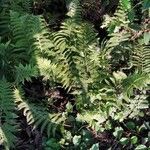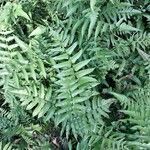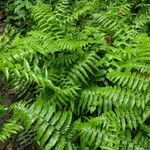Rhizome erect, up to 15 cm tall, densely scaly; scales brown, narrowly lanceolate, ca. 10 × 1 mm, thin, toothed at margin; fronds caespitose. Fertile fronds 60-120 cm; stipe brown-stramineous, 50-60 cm, 3-5 mm in diam. at base, sparsely scaly, upward glabrous or hairy; lamina 1-pinnate or 2-pinnate, deltoid or broadly lanceolate, 60-80 cm or longer, 30-60 cm wide, apex acuminate; pinnae 12-16 pairs, alternate, ascending, lower pinnae stipitate, broadly lanceolate, 16-20 × 6-9 cm, pinnatilobate or 1-pinnate; upper pinnae subsessile, linear-lanceolate, 6-10 × 1-2 cm, base truncate, margin serrate or pinnatilobate (lobes minutely serrate), apex acuminate; veins per lobes pinnate, veinlets 8-10 pairs, ascending, lower 2 or 3 pairs usually conjoined. Lamina stiffly herbaceous, glabrous or hairy, rachis glabrous or hairy; costae shallowly grooved, glabrous or occasionally with light brown short hairs. Sori mostly linear, slightly curved, from near midribs to laminar margin; indusia yellow-brown, linear, membranous, entire. Spore surface with large granular or tuberculate projections. 2n = 82.
More
Rhizome erect, often forming a slender leaning black trunk to 1 m tall, scaly at the apex. Scales c. 1 cm long, dark brown; margins finely toothed; apex long-acuminate. Fronds 1–2 m long, 0.5–1 m wide, erect to arcuate. Stipe black and scaly at the base, paler above. Lamina 2-or 3-pinnate, 0.5–1.5 m long, 0.5–1 m wide, dark green. Secondary pinnae variable in size, commonly 5–8 cm long, 1.5–2.5 cm wide; margins very shallowly lobed; lobes toothed; basal lobes longer than the rest, glabrous beneath; veins simple or forked; lowest 3–5 pairs of adjacent vein groups anastomosing. Sori spreading along most veins; indusium thin, dark brown; margins becoming uneven with age.
A large fern with an upright stem. It forms tufts. It is only woody near the base. It can be 1 m high and 1 m wide. It usually grows as a large clump. It spreads by underground runners. They have feather like fronds which are 50 to 80 cm long and divided 2 or 3 times. The leaf stalks are black near the bottom. The secondary leaflets are pointed at the tip. The end sections of the leaf are many, about 8 cm long and 1 cm wide. The leaflets are notched like a saw and about 2 to 5 cm long.
A tropical plant. It grows in moist tropical places. It mostly occurs in coastal areas. It is common in wet areas. It grows along riversides and in wet areas usually with running water. It grows in wetlands. It also occurs in Malaysia, Indonesia, Philippines and Fiji and is used as a food there. They are widely distributed in the Philippines on areas of gravel and the banks of streams. Plants are frost tender. In Vietnam it grows up to 2,000 m above sea level. In China it grows between 100-1,200 m above sea level. In Yunnan.
More
River banks, open places in wet ground, at elevations below 900 metres in Sri Lanka.
Plants can be grown from spores. They need to be in a well drained potting medium and kept with a high humidity. The spores need a temperature of 21°C and sown as soon as ripe. Plants should be transplanted into a moist well drained soil with partial shade. Plants can also be grown by separating out the underground runners.




